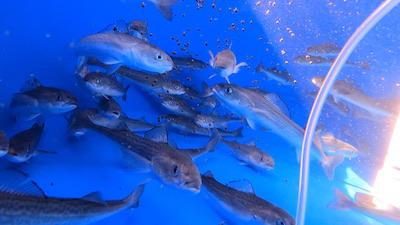Katie Neylan grew up in the Central Valley of California, two hours away from the coast. But when it came time to pick a college, it was the ocean that inspired her. She enrolled at California State University, Monterey Bay, ultimately majoring in marine science, which “felt like the most intriguing area of study,” says Neylan.
Aquaculture and marine resource management, in particular, piqued her interest. “It became clear to me that the global need for fish as a protein source is outpacing what is available through wild-caught fisheries.”
After graduating in 2016, then working as a scientific aide for California Department of Fish and Wildlife, Neylan decided to pursue an advanced degree in finfish aquaculture. She focused her thesis project on one of the greatest challenges in the field: developing a fish-free feed for carnivorous farmed fish.
In particular, she sought a feed for sablefish (Anoplopoma fimbria), which is also known as black cod and valued for its flavorful, buttery flesh. Currently, most sablefish are wild-caught. That’s because farming sablefish, or any carnivorous fish, requires wild-caught forage fish as feed. “It’s one of the biggest bottlenecks for the expansion of the aquaculture industry in general because using wild-caught forage fish as a feed ingredient is not sustainable,” says Neylan.
One of the biggest bottlenecks
The United Nations Food and Agriculture Organization (FAO) has reported that the sheer amount of fish that are processed into fish meal and fish oil to feed farmed salmon, tilapia and other aquacultured fish is taking away food from humans in some regions, including West Africa. Fish farmers are trying to

replace some of the fish in their feeds with terrestrial alternatives like soybean, corn and poultry meal. But this can change a fish’s nutritional profile since these feeds don’t contain as many highly unsaturated omega-3 fatty acids that wild-caught fish have “and that fish consumers want,” says Neylan.
In other words: If a fish doesn’t eat polyunsaturated fatty acids, it will accumulate fewer of these healthy fats in its own tissue. So consumers who eat them may be missing out on those health benefits, says Neylan.
Thriving on a diet of microalga
Neylan wondered whether a polyunsaturated fatty acid-rich microalga called Schizochytrium sp. could be substituted for fish meal and fish oil in the diet of sablefish and still keep them at their usual level of omega-3s. Working out of the Moss Landing Marine Laboratories of San José State University with funding from a California Sea Grant Graduate Research Fellowship, Neylan hand-fed young sablefish diets that contained neither fish oil nor fish meal but instead carefully calibrated amounts of Schizochytrium sp. and other alternative ingredients. She housed the fish in 18 thousand-liter tanks, scooping them out every other week to weigh them. “We used this opportunity to give the fish health checks and scrub the tanks,” she says. “It was a lot of surface area to clean.”
The sablefish thrived on their microalga diet, growing from less than twelve ounces, on average, to over 1.7 pounds in five months. And their filets contained similar levels of omega-3s as sablefish that were fed a diet with fish meal and fish oil. This makes Schizochytrium sp. a viable feed alternative, says Neylan. “It was a really exciting result.” Her study recently got published in the peer-reviewed journal Aquaculture.
She also showcased her project at an international symposium on alternative feed that she co-organized in Seattle, Washington, late last year. “We had fish nutrition scientists from Korea and the U.S. give presentations, and we discussed current research and future collaborations on alternative feeds that can support both the Korean and US aquaculture industries,” says Neylan, who helped invite the speakers and coordinated logistics behind the scenes of the one-day symposium.
Building a diverse skill set
Since finishing her M.S. degree, Neylan is exploring other career paths, again with support from California Sea Grant. She became a California Sea Grant State Fellow and will spend a year at the Department of Transportation, Caltrans, learning how to assess potential impacts of Caltrans projects on fish passage and wildlife connectivity, and about the intricacies of the California Environmental Quality Act and the National Environmental Policy Act.
But even here, she’s keeping a hand in aquaculture and has joined a project to develop an alternative feed for yet another popular seafood species, red abalone.
In this project, the mollusks will be fed diets that include grape pomace, that is the seeds, skins and stems that are left over from winemaking. Initial trials in New Zealand and Australia have shown that abalone can thrive on this food. “It would be a great way to utilize a resource that would otherwise go to waste,” says Neylan. She is currently troubleshooting how to fashion pomace pellets that hold up underwater. “Abalone eat very slowly so the pellets have to last for hours,” she says.
For now, Neylan isn’t sure where the path that once started at Monterey Bay will lead her next. “I'm trying to learn as much as I possibly can this year, and I’m excited to see where I fit in with my diverse skill set after I complete this fellowship.”
About California Sea Grant
NOAA’s California Sea Grant College Program funds marine research, education and outreach throughout California. Headquartered at Scripps Institution of Oceanography at the University of California San Diego, California Sea Grant is one of 34 Sea Grant programs in the National Oceanic and Atmospheric Administration (NOAA), U.S. Department of Commerce.